Comparative Analysis of Business Structures and the ASIC v Adler Case
VerifiedAdded on 2023/06/09
|15
|4190
|203
Case Study
AI Summary
This case study provides legal advice on business structures, comparing partnerships and corporations in the Australian context. It highlights the nature of each structure, including liability, management, and legal entity status. The analysis contrasts the ease of formation and flexibility of partnerships with the limited liability and potential for professional management offered by corporations. The study recommends incorporation for ventures involving family members due to the protection it offers. Furthermore, the case study analyzes the landmark ASIC v Adler case, emphasizing its significance in defining directors' duties under the Corporations Act 2001, particularly the duty of care and diligence. The analysis underscores the importance of corporate governance principles and the consequences of failing to uphold these duties, as demonstrated by the penalties imposed on Rodney Adler for his role in the HIH insurance fraud.
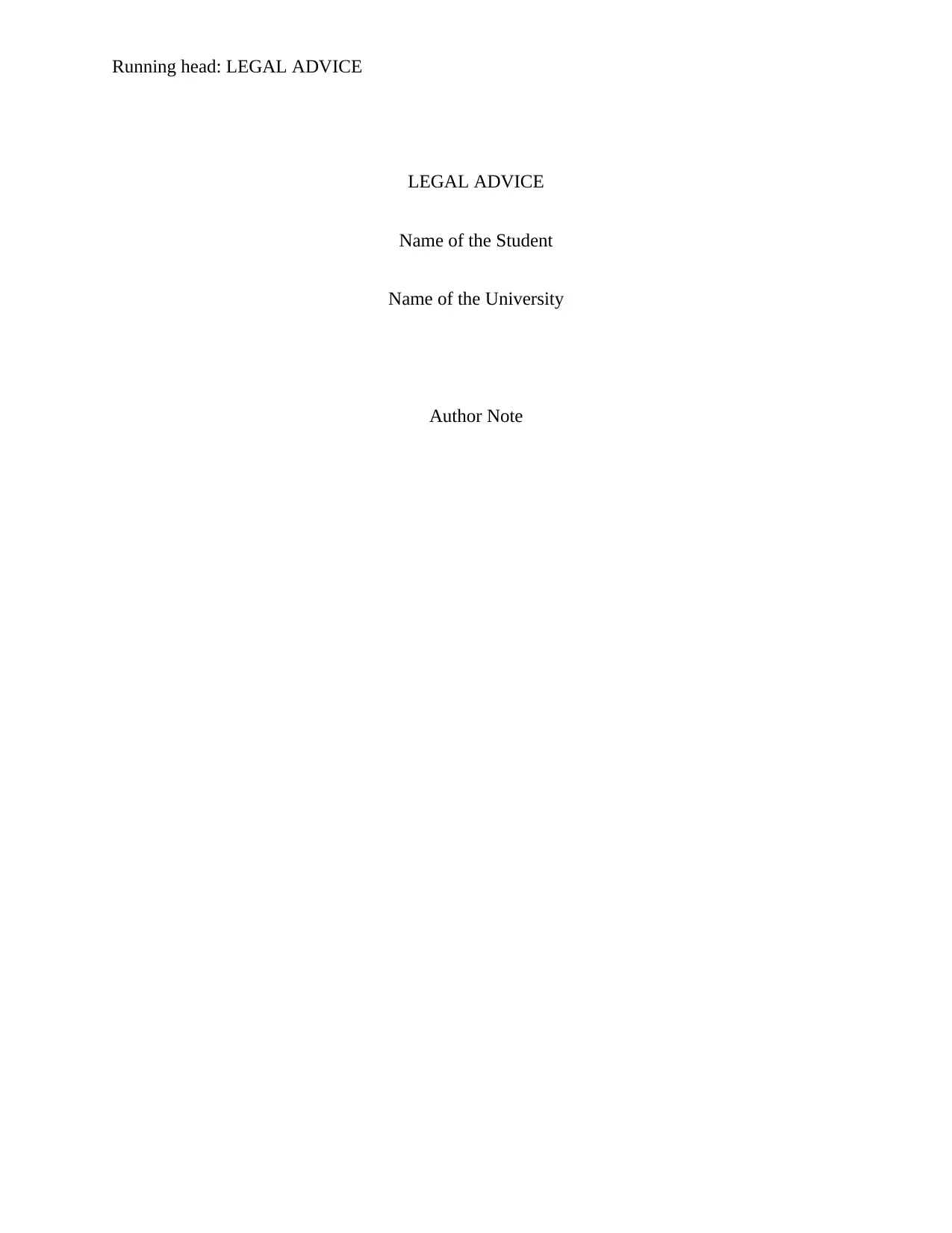
Running head: LEGAL ADVICE
LEGAL ADVICE
Name of the Student
Name of the University
Author Note
LEGAL ADVICE
Name of the Student
Name of the University
Author Note
Paraphrase This Document
Need a fresh take? Get an instant paraphrase of this document with our AI Paraphraser
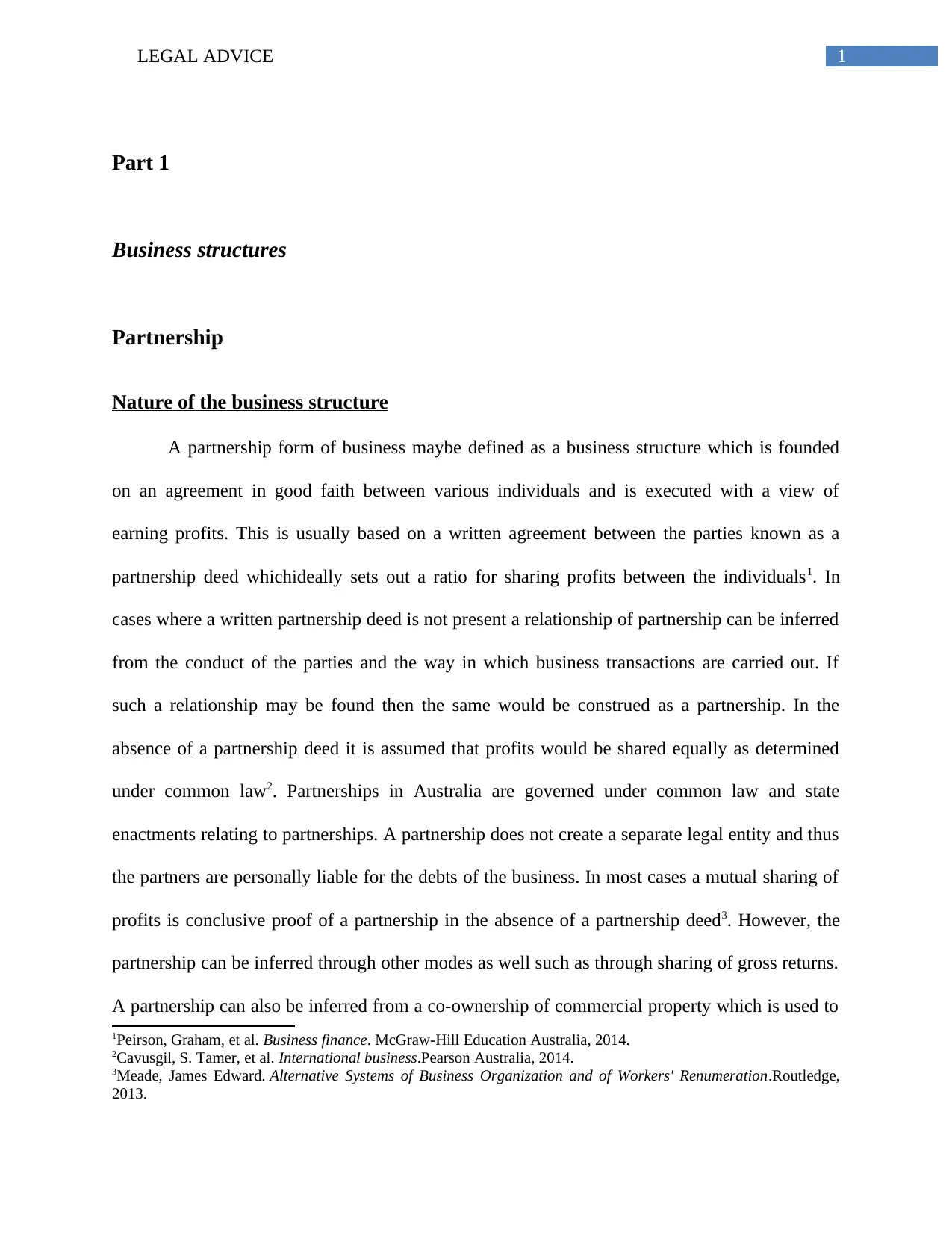
1LEGAL ADVICE
Part 1
Business structures
Partnership
Nature of the business structure
A partnership form of business maybe defined as a business structure which is founded
on an agreement in good faith between various individuals and is executed with a view of
earning profits. This is usually based on a written agreement between the parties known as a
partnership deed whichideally sets out a ratio for sharing profits between the individuals1. In
cases where a written partnership deed is not present a relationship of partnership can be inferred
from the conduct of the parties and the way in which business transactions are carried out. If
such a relationship may be found then the same would be construed as a partnership. In the
absence of a partnership deed it is assumed that profits would be shared equally as determined
under common law2. Partnerships in Australia are governed under common law and state
enactments relating to partnerships. A partnership does not create a separate legal entity and thus
the partners are personally liable for the debts of the business. In most cases a mutual sharing of
profits is conclusive proof of a partnership in the absence of a partnership deed3. However, the
partnership can be inferred through other modes as well such as through sharing of gross returns.
A partnership can also be inferred from a co-ownership of commercial property which is used to
1Peirson, Graham, et al. Business finance. McGraw-Hill Education Australia, 2014.
2Cavusgil, S. Tamer, et al. International business.Pearson Australia, 2014.
3Meade, James Edward. Alternative Systems of Business Organization and of Workers' Renumeration.Routledge,
2013.
Part 1
Business structures
Partnership
Nature of the business structure
A partnership form of business maybe defined as a business structure which is founded
on an agreement in good faith between various individuals and is executed with a view of
earning profits. This is usually based on a written agreement between the parties known as a
partnership deed whichideally sets out a ratio for sharing profits between the individuals1. In
cases where a written partnership deed is not present a relationship of partnership can be inferred
from the conduct of the parties and the way in which business transactions are carried out. If
such a relationship may be found then the same would be construed as a partnership. In the
absence of a partnership deed it is assumed that profits would be shared equally as determined
under common law2. Partnerships in Australia are governed under common law and state
enactments relating to partnerships. A partnership does not create a separate legal entity and thus
the partners are personally liable for the debts of the business. In most cases a mutual sharing of
profits is conclusive proof of a partnership in the absence of a partnership deed3. However, the
partnership can be inferred through other modes as well such as through sharing of gross returns.
A partnership can also be inferred from a co-ownership of commercial property which is used to
1Peirson, Graham, et al. Business finance. McGraw-Hill Education Australia, 2014.
2Cavusgil, S. Tamer, et al. International business.Pearson Australia, 2014.
3Meade, James Edward. Alternative Systems of Business Organization and of Workers' Renumeration.Routledge,
2013.
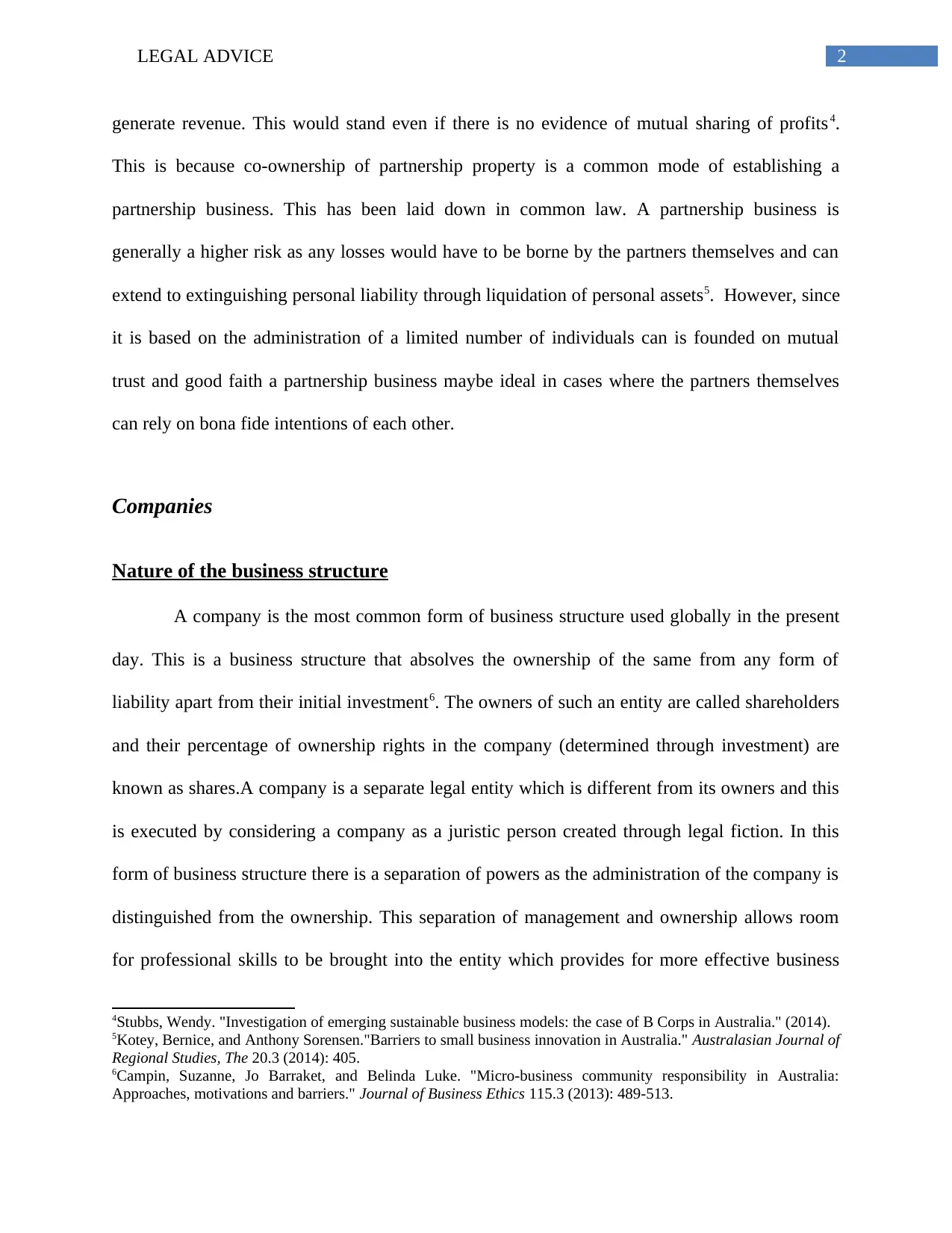
2LEGAL ADVICE
generate revenue. This would stand even if there is no evidence of mutual sharing of profits4.
This is because co-ownership of partnership property is a common mode of establishing a
partnership business. This has been laid down in common law. A partnership business is
generally a higher risk as any losses would have to be borne by the partners themselves and can
extend to extinguishing personal liability through liquidation of personal assets5. However, since
it is based on the administration of a limited number of individuals can is founded on mutual
trust and good faith a partnership business maybe ideal in cases where the partners themselves
can rely on bona fide intentions of each other.
Companies
Nature of the business structure
A company is the most common form of business structure used globally in the present
day. This is a business structure that absolves the ownership of the same from any form of
liability apart from their initial investment6. The owners of such an entity are called shareholders
and their percentage of ownership rights in the company (determined through investment) are
known as shares.A company is a separate legal entity which is different from its owners and this
is executed by considering a company as a juristic person created through legal fiction. In this
form of business structure there is a separation of powers as the administration of the company is
distinguished from the ownership. This separation of management and ownership allows room
for professional skills to be brought into the entity which provides for more effective business
4Stubbs, Wendy. "Investigation of emerging sustainable business models: the case of B Corps in Australia." (2014).
5Kotey, Bernice, and Anthony Sorensen."Barriers to small business innovation in Australia." Australasian Journal of
Regional Studies, The 20.3 (2014): 405.
6Campin, Suzanne, Jo Barraket, and Belinda Luke. "Micro-business community responsibility in Australia:
Approaches, motivations and barriers." Journal of Business Ethics 115.3 (2013): 489-513.
generate revenue. This would stand even if there is no evidence of mutual sharing of profits4.
This is because co-ownership of partnership property is a common mode of establishing a
partnership business. This has been laid down in common law. A partnership business is
generally a higher risk as any losses would have to be borne by the partners themselves and can
extend to extinguishing personal liability through liquidation of personal assets5. However, since
it is based on the administration of a limited number of individuals can is founded on mutual
trust and good faith a partnership business maybe ideal in cases where the partners themselves
can rely on bona fide intentions of each other.
Companies
Nature of the business structure
A company is the most common form of business structure used globally in the present
day. This is a business structure that absolves the ownership of the same from any form of
liability apart from their initial investment6. The owners of such an entity are called shareholders
and their percentage of ownership rights in the company (determined through investment) are
known as shares.A company is a separate legal entity which is different from its owners and this
is executed by considering a company as a juristic person created through legal fiction. In this
form of business structure there is a separation of powers as the administration of the company is
distinguished from the ownership. This separation of management and ownership allows room
for professional skills to be brought into the entity which provides for more effective business
4Stubbs, Wendy. "Investigation of emerging sustainable business models: the case of B Corps in Australia." (2014).
5Kotey, Bernice, and Anthony Sorensen."Barriers to small business innovation in Australia." Australasian Journal of
Regional Studies, The 20.3 (2014): 405.
6Campin, Suzanne, Jo Barraket, and Belinda Luke. "Micro-business community responsibility in Australia:
Approaches, motivations and barriers." Journal of Business Ethics 115.3 (2013): 489-513.
⊘ This is a preview!⊘
Do you want full access?
Subscribe today to unlock all pages.

Trusted by 1+ million students worldwide
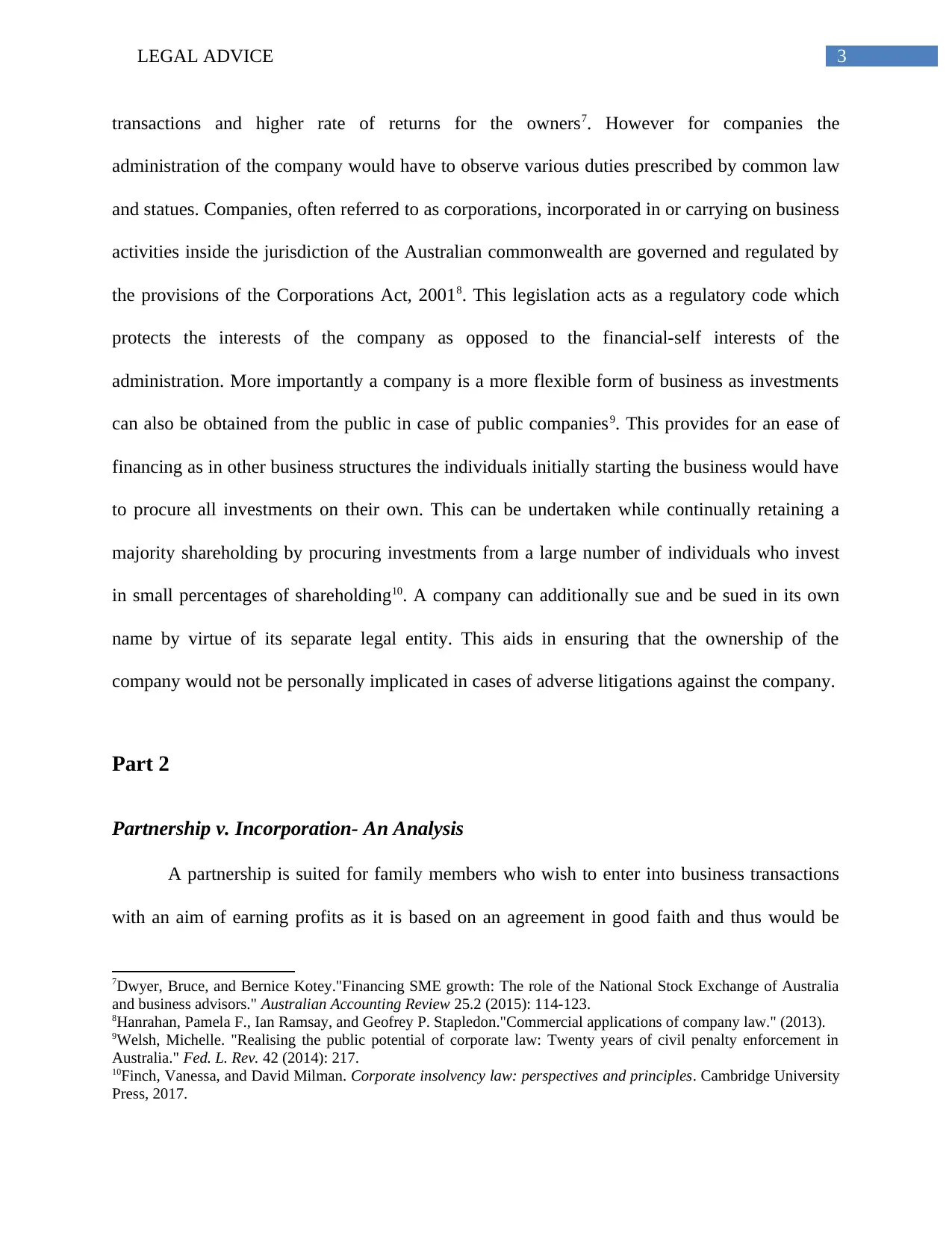
3LEGAL ADVICE
transactions and higher rate of returns for the owners7. However for companies the
administration of the company would have to observe various duties prescribed by common law
and statues. Companies, often referred to as corporations, incorporated in or carrying on business
activities inside the jurisdiction of the Australian commonwealth are governed and regulated by
the provisions of the Corporations Act, 20018. This legislation acts as a regulatory code which
protects the interests of the company as opposed to the financial-self interests of the
administration. More importantly a company is a more flexible form of business as investments
can also be obtained from the public in case of public companies9. This provides for an ease of
financing as in other business structures the individuals initially starting the business would have
to procure all investments on their own. This can be undertaken while continually retaining a
majority shareholding by procuring investments from a large number of individuals who invest
in small percentages of shareholding10. A company can additionally sue and be sued in its own
name by virtue of its separate legal entity. This aids in ensuring that the ownership of the
company would not be personally implicated in cases of adverse litigations against the company.
Part 2
Partnership v. Incorporation- An Analysis
A partnership is suited for family members who wish to enter into business transactions
with an aim of earning profits as it is based on an agreement in good faith and thus would be
7Dwyer, Bruce, and Bernice Kotey."Financing SME growth: The role of the National Stock Exchange of Australia
and business advisors." Australian Accounting Review 25.2 (2015): 114-123.
8Hanrahan, Pamela F., Ian Ramsay, and Geofrey P. Stapledon."Commercial applications of company law." (2013).
9Welsh, Michelle. "Realising the public potential of corporate law: Twenty years of civil penalty enforcement in
Australia." Fed. L. Rev. 42 (2014): 217.
10Finch, Vanessa, and David Milman. Corporate insolvency law: perspectives and principles. Cambridge University
Press, 2017.
transactions and higher rate of returns for the owners7. However for companies the
administration of the company would have to observe various duties prescribed by common law
and statues. Companies, often referred to as corporations, incorporated in or carrying on business
activities inside the jurisdiction of the Australian commonwealth are governed and regulated by
the provisions of the Corporations Act, 20018. This legislation acts as a regulatory code which
protects the interests of the company as opposed to the financial-self interests of the
administration. More importantly a company is a more flexible form of business as investments
can also be obtained from the public in case of public companies9. This provides for an ease of
financing as in other business structures the individuals initially starting the business would have
to procure all investments on their own. This can be undertaken while continually retaining a
majority shareholding by procuring investments from a large number of individuals who invest
in small percentages of shareholding10. A company can additionally sue and be sued in its own
name by virtue of its separate legal entity. This aids in ensuring that the ownership of the
company would not be personally implicated in cases of adverse litigations against the company.
Part 2
Partnership v. Incorporation- An Analysis
A partnership is suited for family members who wish to enter into business transactions
with an aim of earning profits as it is based on an agreement in good faith and thus would be
7Dwyer, Bruce, and Bernice Kotey."Financing SME growth: The role of the National Stock Exchange of Australia
and business advisors." Australian Accounting Review 25.2 (2015): 114-123.
8Hanrahan, Pamela F., Ian Ramsay, and Geofrey P. Stapledon."Commercial applications of company law." (2013).
9Welsh, Michelle. "Realising the public potential of corporate law: Twenty years of civil penalty enforcement in
Australia." Fed. L. Rev. 42 (2014): 217.
10Finch, Vanessa, and David Milman. Corporate insolvency law: perspectives and principles. Cambridge University
Press, 2017.
Paraphrase This Document
Need a fresh take? Get an instant paraphrase of this document with our AI Paraphraser
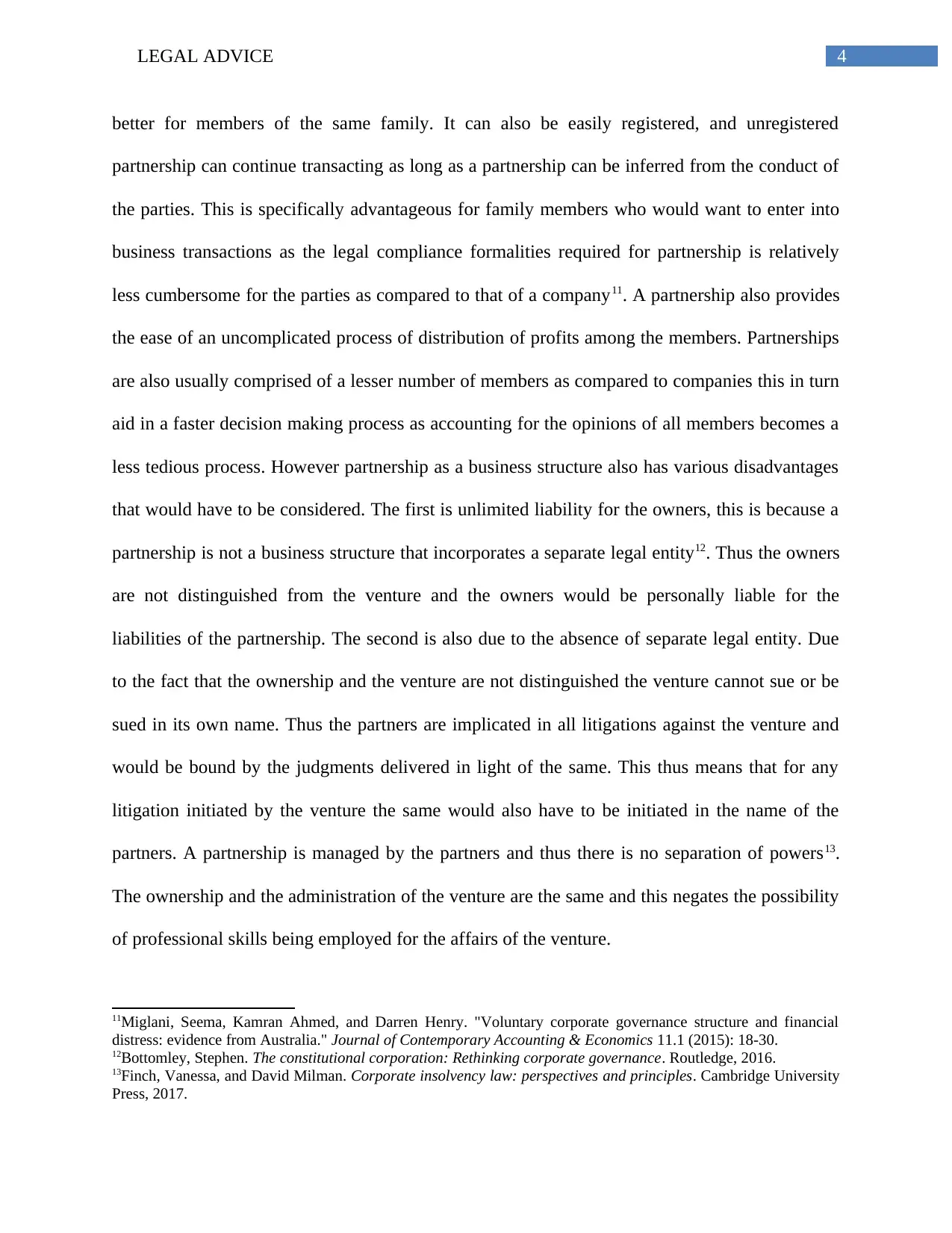
4LEGAL ADVICE
better for members of the same family. It can also be easily registered, and unregistered
partnership can continue transacting as long as a partnership can be inferred from the conduct of
the parties. This is specifically advantageous for family members who would want to enter into
business transactions as the legal compliance formalities required for partnership is relatively
less cumbersome for the parties as compared to that of a company11. A partnership also provides
the ease of an uncomplicated process of distribution of profits among the members. Partnerships
are also usually comprised of a lesser number of members as compared to companies this in turn
aid in a faster decision making process as accounting for the opinions of all members becomes a
less tedious process. However partnership as a business structure also has various disadvantages
that would have to be considered. The first is unlimited liability for the owners, this is because a
partnership is not a business structure that incorporates a separate legal entity12. Thus the owners
are not distinguished from the venture and the owners would be personally liable for the
liabilities of the partnership. The second is also due to the absence of separate legal entity. Due
to the fact that the ownership and the venture are not distinguished the venture cannot sue or be
sued in its own name. Thus the partners are implicated in all litigations against the venture and
would be bound by the judgments delivered in light of the same. This thus means that for any
litigation initiated by the venture the same would also have to be initiated in the name of the
partners. A partnership is managed by the partners and thus there is no separation of powers13.
The ownership and the administration of the venture are the same and this negates the possibility
of professional skills being employed for the affairs of the venture.
11Miglani, Seema, Kamran Ahmed, and Darren Henry. "Voluntary corporate governance structure and financial
distress: evidence from Australia." Journal of Contemporary Accounting & Economics 11.1 (2015): 18-30.
12Bottomley, Stephen. The constitutional corporation: Rethinking corporate governance. Routledge, 2016.
13Finch, Vanessa, and David Milman. Corporate insolvency law: perspectives and principles. Cambridge University
Press, 2017.
better for members of the same family. It can also be easily registered, and unregistered
partnership can continue transacting as long as a partnership can be inferred from the conduct of
the parties. This is specifically advantageous for family members who would want to enter into
business transactions as the legal compliance formalities required for partnership is relatively
less cumbersome for the parties as compared to that of a company11. A partnership also provides
the ease of an uncomplicated process of distribution of profits among the members. Partnerships
are also usually comprised of a lesser number of members as compared to companies this in turn
aid in a faster decision making process as accounting for the opinions of all members becomes a
less tedious process. However partnership as a business structure also has various disadvantages
that would have to be considered. The first is unlimited liability for the owners, this is because a
partnership is not a business structure that incorporates a separate legal entity12. Thus the owners
are not distinguished from the venture and the owners would be personally liable for the
liabilities of the partnership. The second is also due to the absence of separate legal entity. Due
to the fact that the ownership and the venture are not distinguished the venture cannot sue or be
sued in its own name. Thus the partners are implicated in all litigations against the venture and
would be bound by the judgments delivered in light of the same. This thus means that for any
litigation initiated by the venture the same would also have to be initiated in the name of the
partners. A partnership is managed by the partners and thus there is no separation of powers13.
The ownership and the administration of the venture are the same and this negates the possibility
of professional skills being employed for the affairs of the venture.
11Miglani, Seema, Kamran Ahmed, and Darren Henry. "Voluntary corporate governance structure and financial
distress: evidence from Australia." Journal of Contemporary Accounting & Economics 11.1 (2015): 18-30.
12Bottomley, Stephen. The constitutional corporation: Rethinking corporate governance. Routledge, 2016.
13Finch, Vanessa, and David Milman. Corporate insolvency law: perspectives and principles. Cambridge University
Press, 2017.
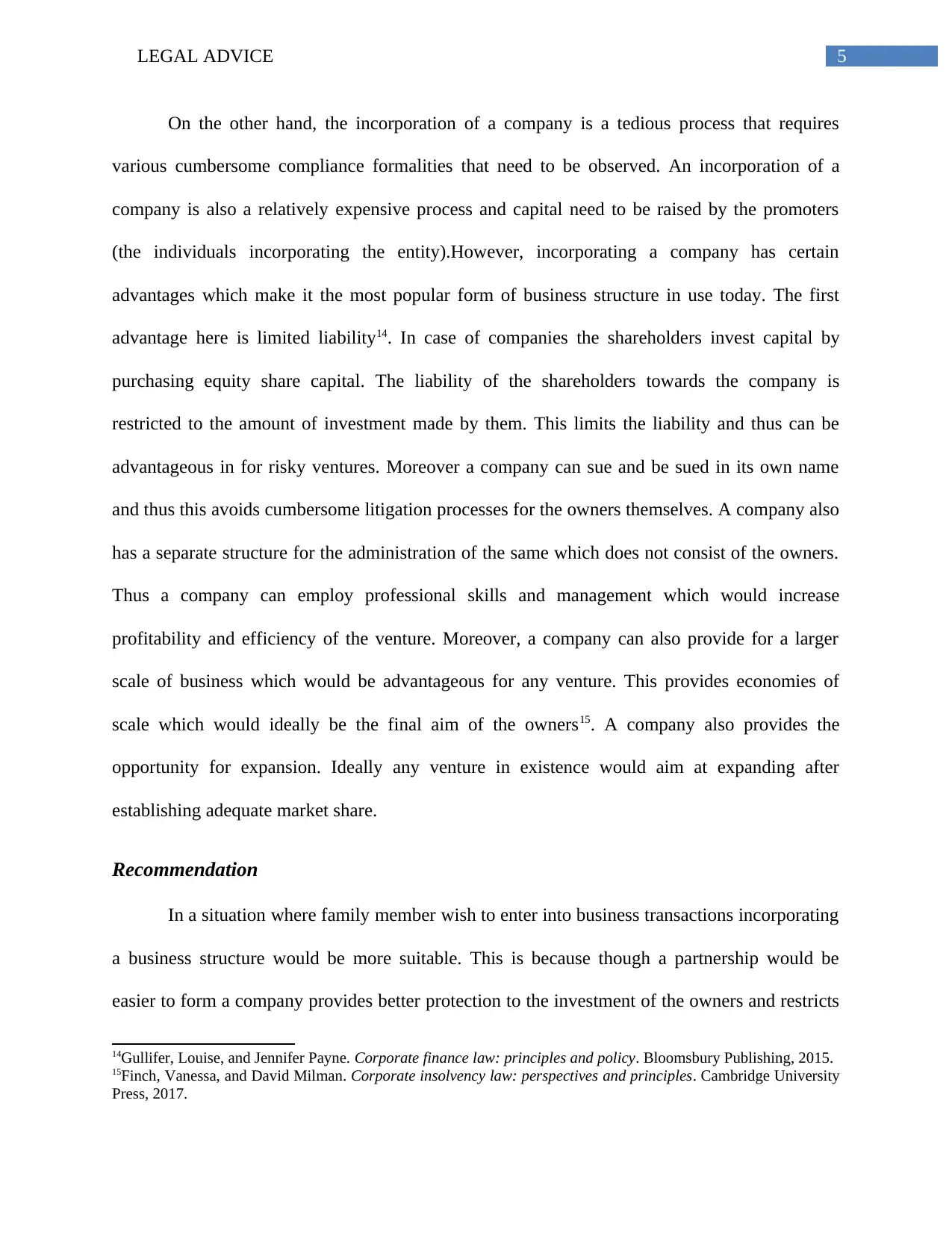
5LEGAL ADVICE
On the other hand, the incorporation of a company is a tedious process that requires
various cumbersome compliance formalities that need to be observed. An incorporation of a
company is also a relatively expensive process and capital need to be raised by the promoters
(the individuals incorporating the entity).However, incorporating a company has certain
advantages which make it the most popular form of business structure in use today. The first
advantage here is limited liability14. In case of companies the shareholders invest capital by
purchasing equity share capital. The liability of the shareholders towards the company is
restricted to the amount of investment made by them. This limits the liability and thus can be
advantageous in for risky ventures. Moreover a company can sue and be sued in its own name
and thus this avoids cumbersome litigation processes for the owners themselves. A company also
has a separate structure for the administration of the same which does not consist of the owners.
Thus a company can employ professional skills and management which would increase
profitability and efficiency of the venture. Moreover, a company can also provide for a larger
scale of business which would be advantageous for any venture. This provides economies of
scale which would ideally be the final aim of the owners15. A company also provides the
opportunity for expansion. Ideally any venture in existence would aim at expanding after
establishing adequate market share.
Recommendation
In a situation where family member wish to enter into business transactions incorporating
a business structure would be more suitable. This is because though a partnership would be
easier to form a company provides better protection to the investment of the owners and restricts
14Gullifer, Louise, and Jennifer Payne. Corporate finance law: principles and policy. Bloomsbury Publishing, 2015.
15Finch, Vanessa, and David Milman. Corporate insolvency law: perspectives and principles. Cambridge University
Press, 2017.
On the other hand, the incorporation of a company is a tedious process that requires
various cumbersome compliance formalities that need to be observed. An incorporation of a
company is also a relatively expensive process and capital need to be raised by the promoters
(the individuals incorporating the entity).However, incorporating a company has certain
advantages which make it the most popular form of business structure in use today. The first
advantage here is limited liability14. In case of companies the shareholders invest capital by
purchasing equity share capital. The liability of the shareholders towards the company is
restricted to the amount of investment made by them. This limits the liability and thus can be
advantageous in for risky ventures. Moreover a company can sue and be sued in its own name
and thus this avoids cumbersome litigation processes for the owners themselves. A company also
has a separate structure for the administration of the same which does not consist of the owners.
Thus a company can employ professional skills and management which would increase
profitability and efficiency of the venture. Moreover, a company can also provide for a larger
scale of business which would be advantageous for any venture. This provides economies of
scale which would ideally be the final aim of the owners15. A company also provides the
opportunity for expansion. Ideally any venture in existence would aim at expanding after
establishing adequate market share.
Recommendation
In a situation where family member wish to enter into business transactions incorporating
a business structure would be more suitable. This is because though a partnership would be
easier to form a company provides better protection to the investment of the owners and restricts
14Gullifer, Louise, and Jennifer Payne. Corporate finance law: principles and policy. Bloomsbury Publishing, 2015.
15Finch, Vanessa, and David Milman. Corporate insolvency law: perspectives and principles. Cambridge University
Press, 2017.
⊘ This is a preview!⊘
Do you want full access?
Subscribe today to unlock all pages.

Trusted by 1+ million students worldwide
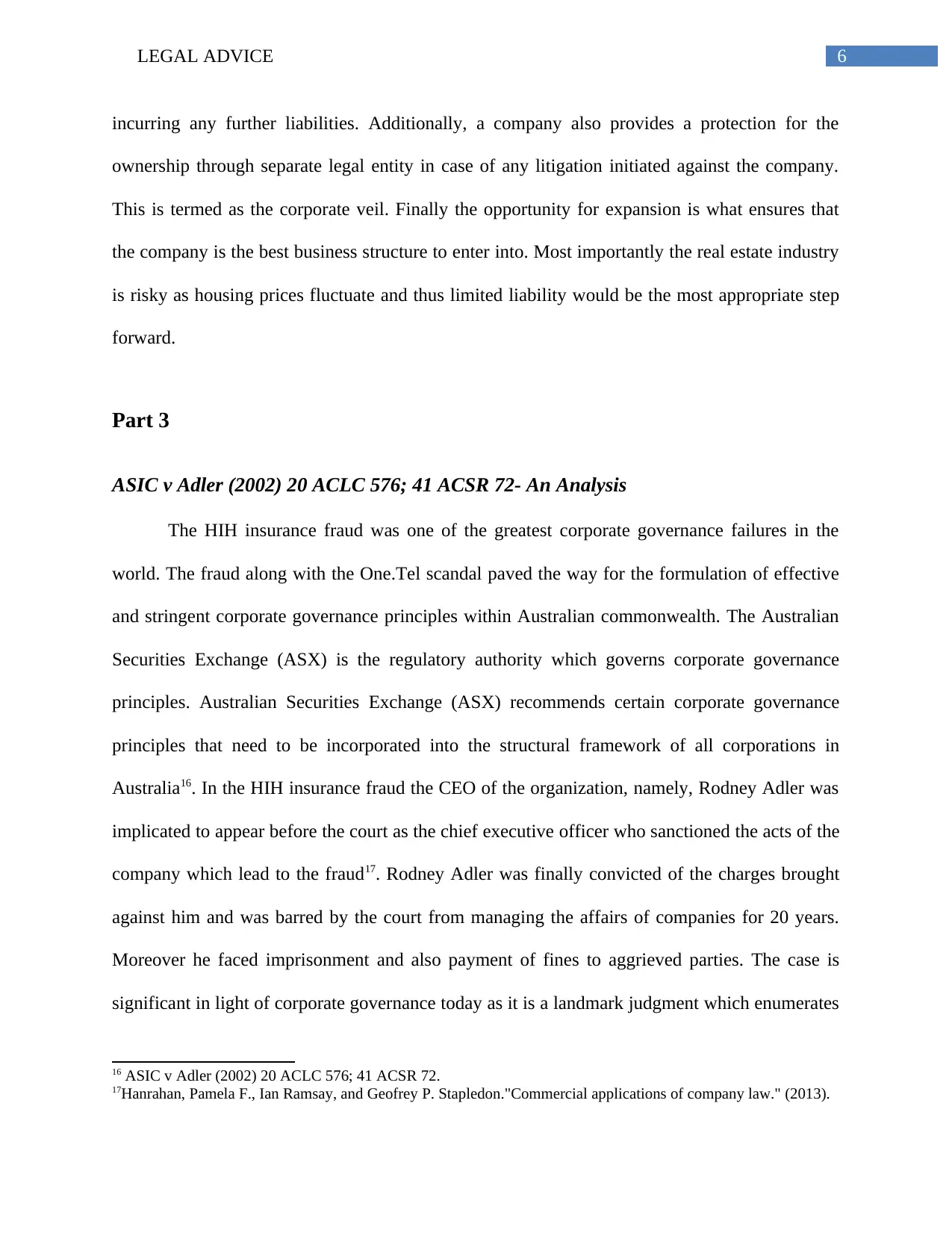
6LEGAL ADVICE
incurring any further liabilities. Additionally, a company also provides a protection for the
ownership through separate legal entity in case of any litigation initiated against the company.
This is termed as the corporate veil. Finally the opportunity for expansion is what ensures that
the company is the best business structure to enter into. Most importantly the real estate industry
is risky as housing prices fluctuate and thus limited liability would be the most appropriate step
forward.
Part 3
ASIC v Adler (2002) 20 ACLC 576; 41 ACSR 72- An Analysis
The HIH insurance fraud was one of the greatest corporate governance failures in the
world. The fraud along with the One.Tel scandal paved the way for the formulation of effective
and stringent corporate governance principles within Australian commonwealth. The Australian
Securities Exchange (ASX) is the regulatory authority which governs corporate governance
principles. Australian Securities Exchange (ASX) recommends certain corporate governance
principles that need to be incorporated into the structural framework of all corporations in
Australia16. In the HIH insurance fraud the CEO of the organization, namely, Rodney Adler was
implicated to appear before the court as the chief executive officer who sanctioned the acts of the
company which lead to the fraud17. Rodney Adler was finally convicted of the charges brought
against him and was barred by the court from managing the affairs of companies for 20 years.
Moreover he faced imprisonment and also payment of fines to aggrieved parties. The case is
significant in light of corporate governance today as it is a landmark judgment which enumerates
16 ASIC v Adler (2002) 20 ACLC 576; 41 ACSR 72.
17Hanrahan, Pamela F., Ian Ramsay, and Geofrey P. Stapledon."Commercial applications of company law." (2013).
incurring any further liabilities. Additionally, a company also provides a protection for the
ownership through separate legal entity in case of any litigation initiated against the company.
This is termed as the corporate veil. Finally the opportunity for expansion is what ensures that
the company is the best business structure to enter into. Most importantly the real estate industry
is risky as housing prices fluctuate and thus limited liability would be the most appropriate step
forward.
Part 3
ASIC v Adler (2002) 20 ACLC 576; 41 ACSR 72- An Analysis
The HIH insurance fraud was one of the greatest corporate governance failures in the
world. The fraud along with the One.Tel scandal paved the way for the formulation of effective
and stringent corporate governance principles within Australian commonwealth. The Australian
Securities Exchange (ASX) is the regulatory authority which governs corporate governance
principles. Australian Securities Exchange (ASX) recommends certain corporate governance
principles that need to be incorporated into the structural framework of all corporations in
Australia16. In the HIH insurance fraud the CEO of the organization, namely, Rodney Adler was
implicated to appear before the court as the chief executive officer who sanctioned the acts of the
company which lead to the fraud17. Rodney Adler was finally convicted of the charges brought
against him and was barred by the court from managing the affairs of companies for 20 years.
Moreover he faced imprisonment and also payment of fines to aggrieved parties. The case is
significant in light of corporate governance today as it is a landmark judgment which enumerates
16 ASIC v Adler (2002) 20 ACLC 576; 41 ACSR 72.
17Hanrahan, Pamela F., Ian Ramsay, and Geofrey P. Stapledon."Commercial applications of company law." (2013).
Paraphrase This Document
Need a fresh take? Get an instant paraphrase of this document with our AI Paraphraser
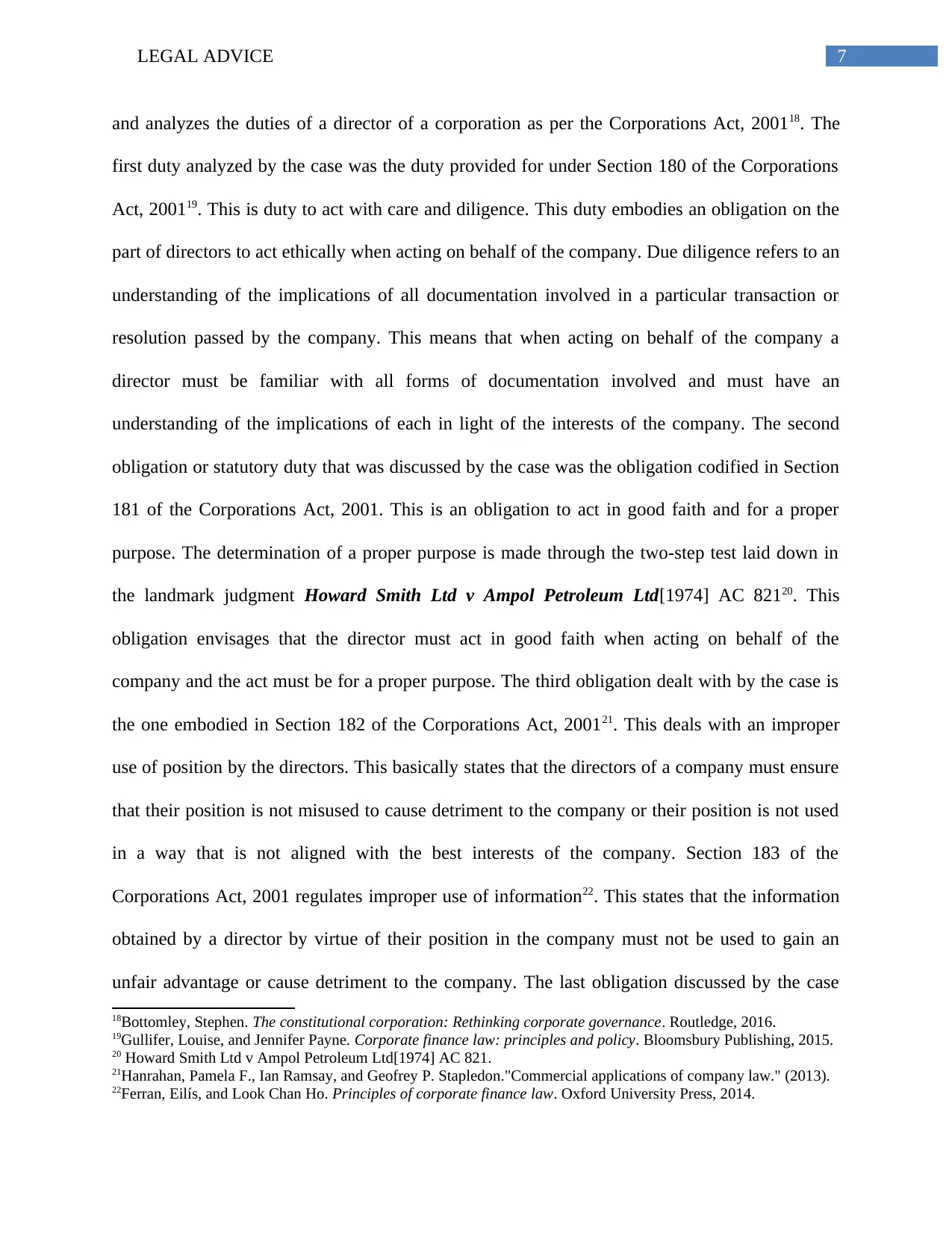
7LEGAL ADVICE
and analyzes the duties of a director of a corporation as per the Corporations Act, 200118. The
first duty analyzed by the case was the duty provided for under Section 180 of the Corporations
Act, 200119. This is duty to act with care and diligence. This duty embodies an obligation on the
part of directors to act ethically when acting on behalf of the company. Due diligence refers to an
understanding of the implications of all documentation involved in a particular transaction or
resolution passed by the company. This means that when acting on behalf of the company a
director must be familiar with all forms of documentation involved and must have an
understanding of the implications of each in light of the interests of the company. The second
obligation or statutory duty that was discussed by the case was the obligation codified in Section
181 of the Corporations Act, 2001. This is an obligation to act in good faith and for a proper
purpose. The determination of a proper purpose is made through the two-step test laid down in
the landmark judgment Howard Smith Ltd v Ampol Petroleum Ltd[1974] AC 82120. This
obligation envisages that the director must act in good faith when acting on behalf of the
company and the act must be for a proper purpose. The third obligation dealt with by the case is
the one embodied in Section 182 of the Corporations Act, 200121. This deals with an improper
use of position by the directors. This basically states that the directors of a company must ensure
that their position is not misused to cause detriment to the company or their position is not used
in a way that is not aligned with the best interests of the company. Section 183 of the
Corporations Act, 2001 regulates improper use of information22. This states that the information
obtained by a director by virtue of their position in the company must not be used to gain an
unfair advantage or cause detriment to the company. The last obligation discussed by the case
18Bottomley, Stephen. The constitutional corporation: Rethinking corporate governance. Routledge, 2016.
19Gullifer, Louise, and Jennifer Payne. Corporate finance law: principles and policy. Bloomsbury Publishing, 2015.
20 Howard Smith Ltd v Ampol Petroleum Ltd[1974] AC 821.
21Hanrahan, Pamela F., Ian Ramsay, and Geofrey P. Stapledon."Commercial applications of company law." (2013).
22Ferran, Eilís, and Look Chan Ho. Principles of corporate finance law. Oxford University Press, 2014.
and analyzes the duties of a director of a corporation as per the Corporations Act, 200118. The
first duty analyzed by the case was the duty provided for under Section 180 of the Corporations
Act, 200119. This is duty to act with care and diligence. This duty embodies an obligation on the
part of directors to act ethically when acting on behalf of the company. Due diligence refers to an
understanding of the implications of all documentation involved in a particular transaction or
resolution passed by the company. This means that when acting on behalf of the company a
director must be familiar with all forms of documentation involved and must have an
understanding of the implications of each in light of the interests of the company. The second
obligation or statutory duty that was discussed by the case was the obligation codified in Section
181 of the Corporations Act, 2001. This is an obligation to act in good faith and for a proper
purpose. The determination of a proper purpose is made through the two-step test laid down in
the landmark judgment Howard Smith Ltd v Ampol Petroleum Ltd[1974] AC 82120. This
obligation envisages that the director must act in good faith when acting on behalf of the
company and the act must be for a proper purpose. The third obligation dealt with by the case is
the one embodied in Section 182 of the Corporations Act, 200121. This deals with an improper
use of position by the directors. This basically states that the directors of a company must ensure
that their position is not misused to cause detriment to the company or their position is not used
in a way that is not aligned with the best interests of the company. Section 183 of the
Corporations Act, 2001 regulates improper use of information22. This states that the information
obtained by a director by virtue of their position in the company must not be used to gain an
unfair advantage or cause detriment to the company. The last obligation discussed by the case
18Bottomley, Stephen. The constitutional corporation: Rethinking corporate governance. Routledge, 2016.
19Gullifer, Louise, and Jennifer Payne. Corporate finance law: principles and policy. Bloomsbury Publishing, 2015.
20 Howard Smith Ltd v Ampol Petroleum Ltd[1974] AC 821.
21Hanrahan, Pamela F., Ian Ramsay, and Geofrey P. Stapledon."Commercial applications of company law." (2013).
22Ferran, Eilís, and Look Chan Ho. Principles of corporate finance law. Oxford University Press, 2014.
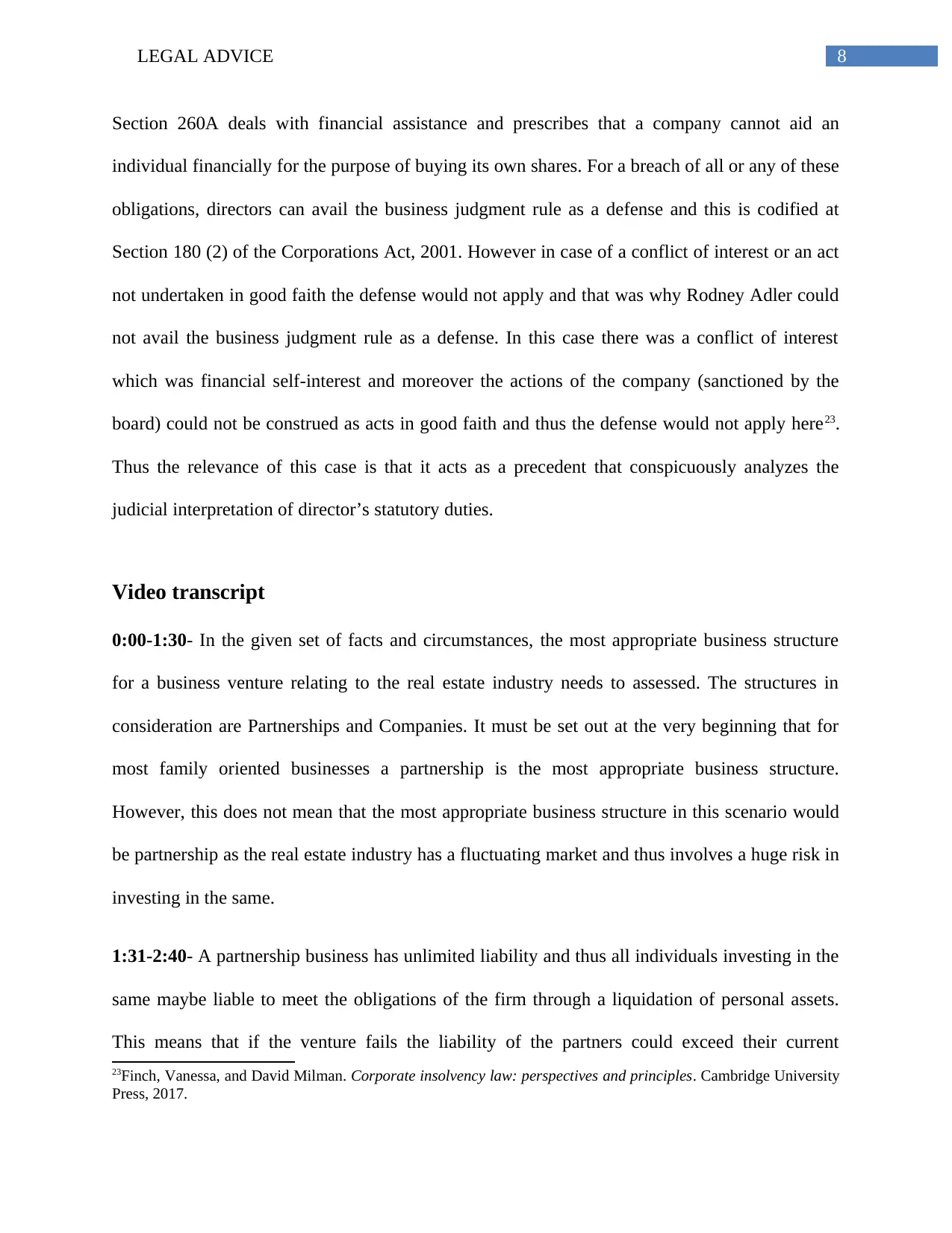
8LEGAL ADVICE
Section 260A deals with financial assistance and prescribes that a company cannot aid an
individual financially for the purpose of buying its own shares. For a breach of all or any of these
obligations, directors can avail the business judgment rule as a defense and this is codified at
Section 180 (2) of the Corporations Act, 2001. However in case of a conflict of interest or an act
not undertaken in good faith the defense would not apply and that was why Rodney Adler could
not avail the business judgment rule as a defense. In this case there was a conflict of interest
which was financial self-interest and moreover the actions of the company (sanctioned by the
board) could not be construed as acts in good faith and thus the defense would not apply here23.
Thus the relevance of this case is that it acts as a precedent that conspicuously analyzes the
judicial interpretation of director’s statutory duties.
Video transcript
0:00-1:30- In the given set of facts and circumstances, the most appropriate business structure
for a business venture relating to the real estate industry needs to assessed. The structures in
consideration are Partnerships and Companies. It must be set out at the very beginning that for
most family oriented businesses a partnership is the most appropriate business structure.
However, this does not mean that the most appropriate business structure in this scenario would
be partnership as the real estate industry has a fluctuating market and thus involves a huge risk in
investing in the same.
1:31-2:40- A partnership business has unlimited liability and thus all individuals investing in the
same maybe liable to meet the obligations of the firm through a liquidation of personal assets.
This means that if the venture fails the liability of the partners could exceed their current
23Finch, Vanessa, and David Milman. Corporate insolvency law: perspectives and principles. Cambridge University
Press, 2017.
Section 260A deals with financial assistance and prescribes that a company cannot aid an
individual financially for the purpose of buying its own shares. For a breach of all or any of these
obligations, directors can avail the business judgment rule as a defense and this is codified at
Section 180 (2) of the Corporations Act, 2001. However in case of a conflict of interest or an act
not undertaken in good faith the defense would not apply and that was why Rodney Adler could
not avail the business judgment rule as a defense. In this case there was a conflict of interest
which was financial self-interest and moreover the actions of the company (sanctioned by the
board) could not be construed as acts in good faith and thus the defense would not apply here23.
Thus the relevance of this case is that it acts as a precedent that conspicuously analyzes the
judicial interpretation of director’s statutory duties.
Video transcript
0:00-1:30- In the given set of facts and circumstances, the most appropriate business structure
for a business venture relating to the real estate industry needs to assessed. The structures in
consideration are Partnerships and Companies. It must be set out at the very beginning that for
most family oriented businesses a partnership is the most appropriate business structure.
However, this does not mean that the most appropriate business structure in this scenario would
be partnership as the real estate industry has a fluctuating market and thus involves a huge risk in
investing in the same.
1:31-2:40- A partnership business has unlimited liability and thus all individuals investing in the
same maybe liable to meet the obligations of the firm through a liquidation of personal assets.
This means that if the venture fails the liability of the partners could exceed their current
23Finch, Vanessa, and David Milman. Corporate insolvency law: perspectives and principles. Cambridge University
Press, 2017.
⊘ This is a preview!⊘
Do you want full access?
Subscribe today to unlock all pages.

Trusted by 1+ million students worldwide
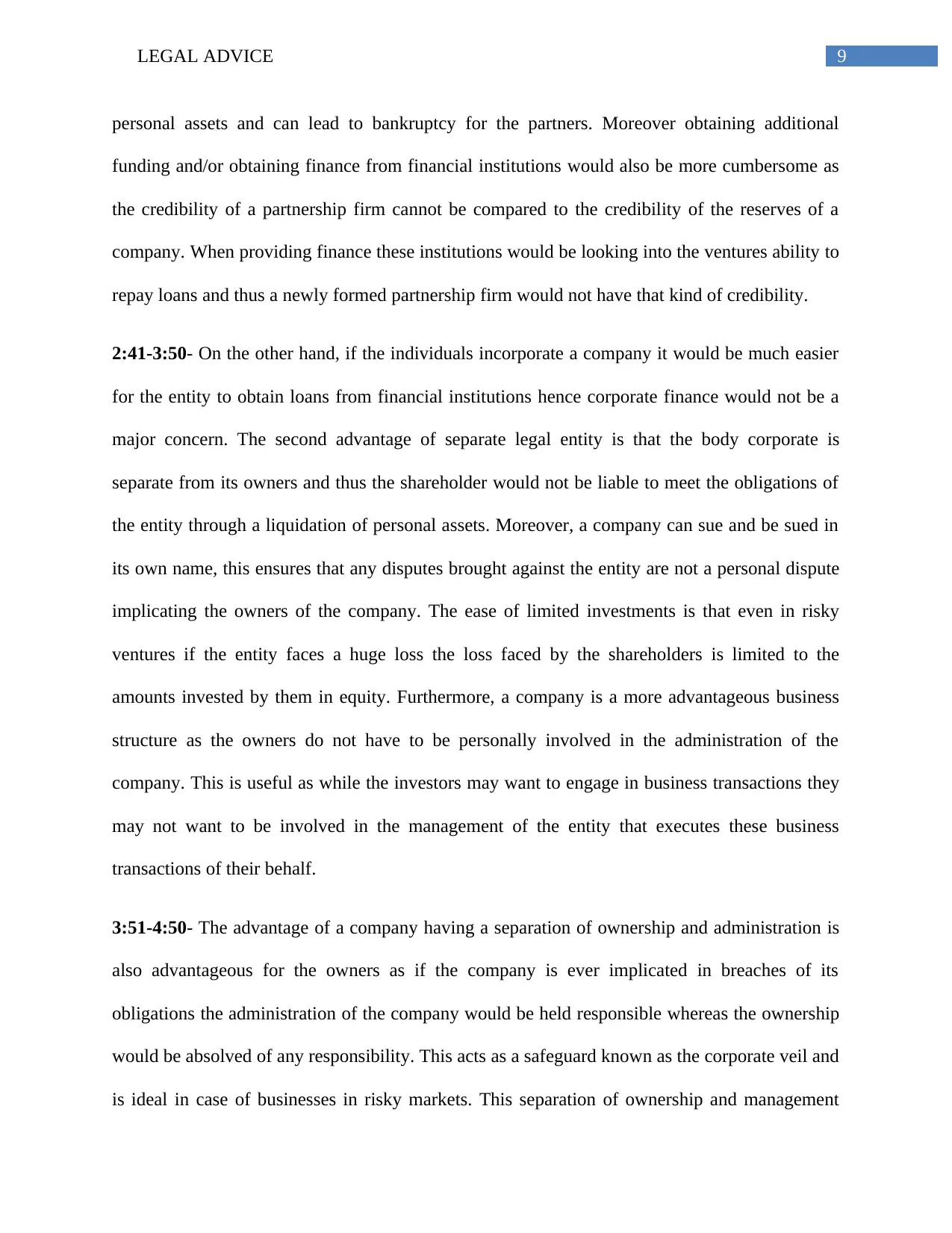
9LEGAL ADVICE
personal assets and can lead to bankruptcy for the partners. Moreover obtaining additional
funding and/or obtaining finance from financial institutions would also be more cumbersome as
the credibility of a partnership firm cannot be compared to the credibility of the reserves of a
company. When providing finance these institutions would be looking into the ventures ability to
repay loans and thus a newly formed partnership firm would not have that kind of credibility.
2:41-3:50- On the other hand, if the individuals incorporate a company it would be much easier
for the entity to obtain loans from financial institutions hence corporate finance would not be a
major concern. The second advantage of separate legal entity is that the body corporate is
separate from its owners and thus the shareholder would not be liable to meet the obligations of
the entity through a liquidation of personal assets. Moreover, a company can sue and be sued in
its own name, this ensures that any disputes brought against the entity are not a personal dispute
implicating the owners of the company. The ease of limited investments is that even in risky
ventures if the entity faces a huge loss the loss faced by the shareholders is limited to the
amounts invested by them in equity. Furthermore, a company is a more advantageous business
structure as the owners do not have to be personally involved in the administration of the
company. This is useful as while the investors may want to engage in business transactions they
may not want to be involved in the management of the entity that executes these business
transactions of their behalf.
3:51-4:50- The advantage of a company having a separation of ownership and administration is
also advantageous for the owners as if the company is ever implicated in breaches of its
obligations the administration of the company would be held responsible whereas the ownership
would be absolved of any responsibility. This acts as a safeguard known as the corporate veil and
is ideal in case of businesses in risky markets. This separation of ownership and management
personal assets and can lead to bankruptcy for the partners. Moreover obtaining additional
funding and/or obtaining finance from financial institutions would also be more cumbersome as
the credibility of a partnership firm cannot be compared to the credibility of the reserves of a
company. When providing finance these institutions would be looking into the ventures ability to
repay loans and thus a newly formed partnership firm would not have that kind of credibility.
2:41-3:50- On the other hand, if the individuals incorporate a company it would be much easier
for the entity to obtain loans from financial institutions hence corporate finance would not be a
major concern. The second advantage of separate legal entity is that the body corporate is
separate from its owners and thus the shareholder would not be liable to meet the obligations of
the entity through a liquidation of personal assets. Moreover, a company can sue and be sued in
its own name, this ensures that any disputes brought against the entity are not a personal dispute
implicating the owners of the company. The ease of limited investments is that even in risky
ventures if the entity faces a huge loss the loss faced by the shareholders is limited to the
amounts invested by them in equity. Furthermore, a company is a more advantageous business
structure as the owners do not have to be personally involved in the administration of the
company. This is useful as while the investors may want to engage in business transactions they
may not want to be involved in the management of the entity that executes these business
transactions of their behalf.
3:51-4:50- The advantage of a company having a separation of ownership and administration is
also advantageous for the owners as if the company is ever implicated in breaches of its
obligations the administration of the company would be held responsible whereas the ownership
would be absolved of any responsibility. This acts as a safeguard known as the corporate veil and
is ideal in case of businesses in risky markets. This separation of ownership and management
Paraphrase This Document
Need a fresh take? Get an instant paraphrase of this document with our AI Paraphraser
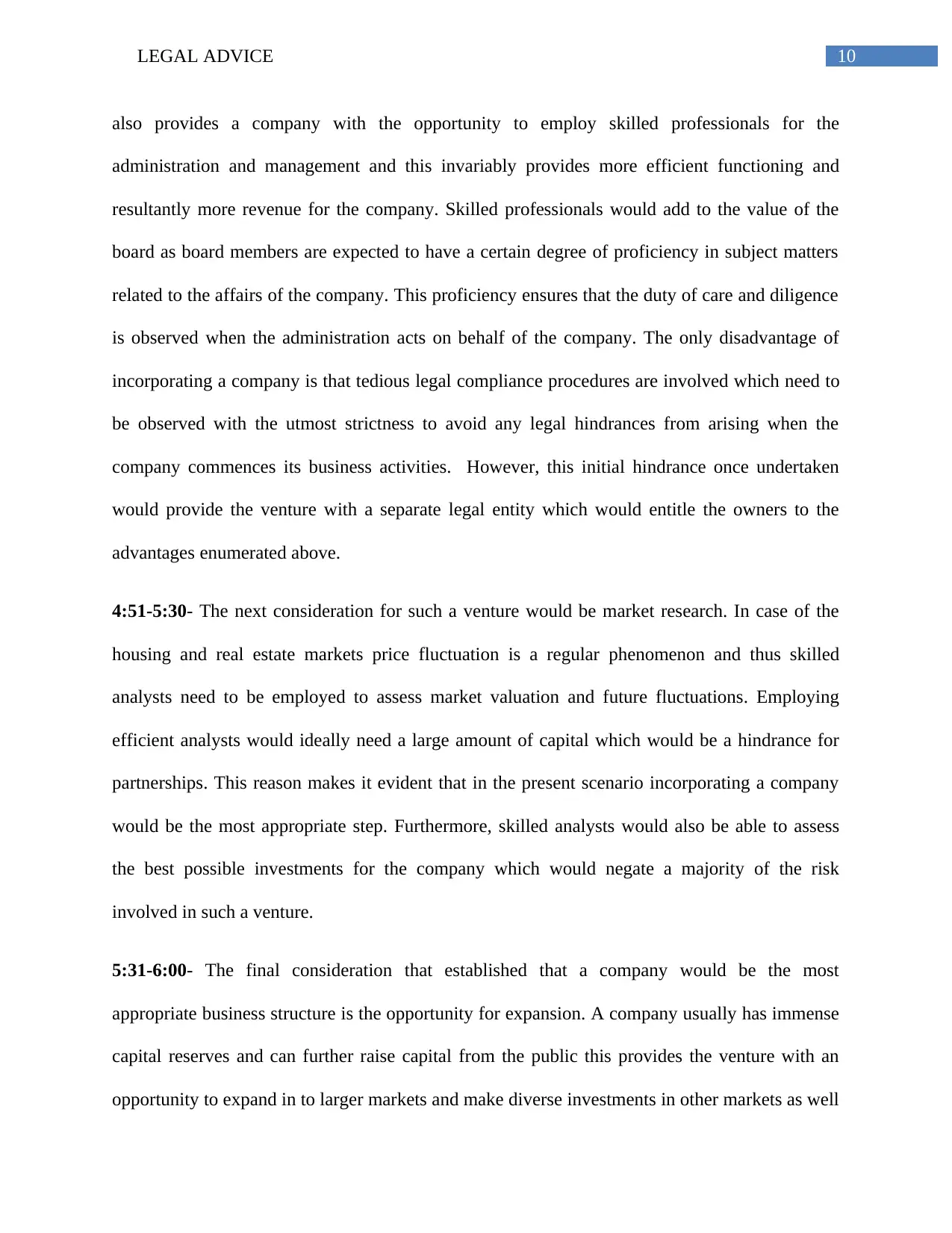
10LEGAL ADVICE
also provides a company with the opportunity to employ skilled professionals for the
administration and management and this invariably provides more efficient functioning and
resultantly more revenue for the company. Skilled professionals would add to the value of the
board as board members are expected to have a certain degree of proficiency in subject matters
related to the affairs of the company. This proficiency ensures that the duty of care and diligence
is observed when the administration acts on behalf of the company. The only disadvantage of
incorporating a company is that tedious legal compliance procedures are involved which need to
be observed with the utmost strictness to avoid any legal hindrances from arising when the
company commences its business activities. However, this initial hindrance once undertaken
would provide the venture with a separate legal entity which would entitle the owners to the
advantages enumerated above.
4:51-5:30- The next consideration for such a venture would be market research. In case of the
housing and real estate markets price fluctuation is a regular phenomenon and thus skilled
analysts need to be employed to assess market valuation and future fluctuations. Employing
efficient analysts would ideally need a large amount of capital which would be a hindrance for
partnerships. This reason makes it evident that in the present scenario incorporating a company
would be the most appropriate step. Furthermore, skilled analysts would also be able to assess
the best possible investments for the company which would negate a majority of the risk
involved in such a venture.
5:31-6:00- The final consideration that established that a company would be the most
appropriate business structure is the opportunity for expansion. A company usually has immense
capital reserves and can further raise capital from the public this provides the venture with an
opportunity to expand in to larger markets and make diverse investments in other markets as well
also provides a company with the opportunity to employ skilled professionals for the
administration and management and this invariably provides more efficient functioning and
resultantly more revenue for the company. Skilled professionals would add to the value of the
board as board members are expected to have a certain degree of proficiency in subject matters
related to the affairs of the company. This proficiency ensures that the duty of care and diligence
is observed when the administration acts on behalf of the company. The only disadvantage of
incorporating a company is that tedious legal compliance procedures are involved which need to
be observed with the utmost strictness to avoid any legal hindrances from arising when the
company commences its business activities. However, this initial hindrance once undertaken
would provide the venture with a separate legal entity which would entitle the owners to the
advantages enumerated above.
4:51-5:30- The next consideration for such a venture would be market research. In case of the
housing and real estate markets price fluctuation is a regular phenomenon and thus skilled
analysts need to be employed to assess market valuation and future fluctuations. Employing
efficient analysts would ideally need a large amount of capital which would be a hindrance for
partnerships. This reason makes it evident that in the present scenario incorporating a company
would be the most appropriate step. Furthermore, skilled analysts would also be able to assess
the best possible investments for the company which would negate a majority of the risk
involved in such a venture.
5:31-6:00- The final consideration that established that a company would be the most
appropriate business structure is the opportunity for expansion. A company usually has immense
capital reserves and can further raise capital from the public this provides the venture with an
opportunity to expand in to larger markets and make diverse investments in other markets as well
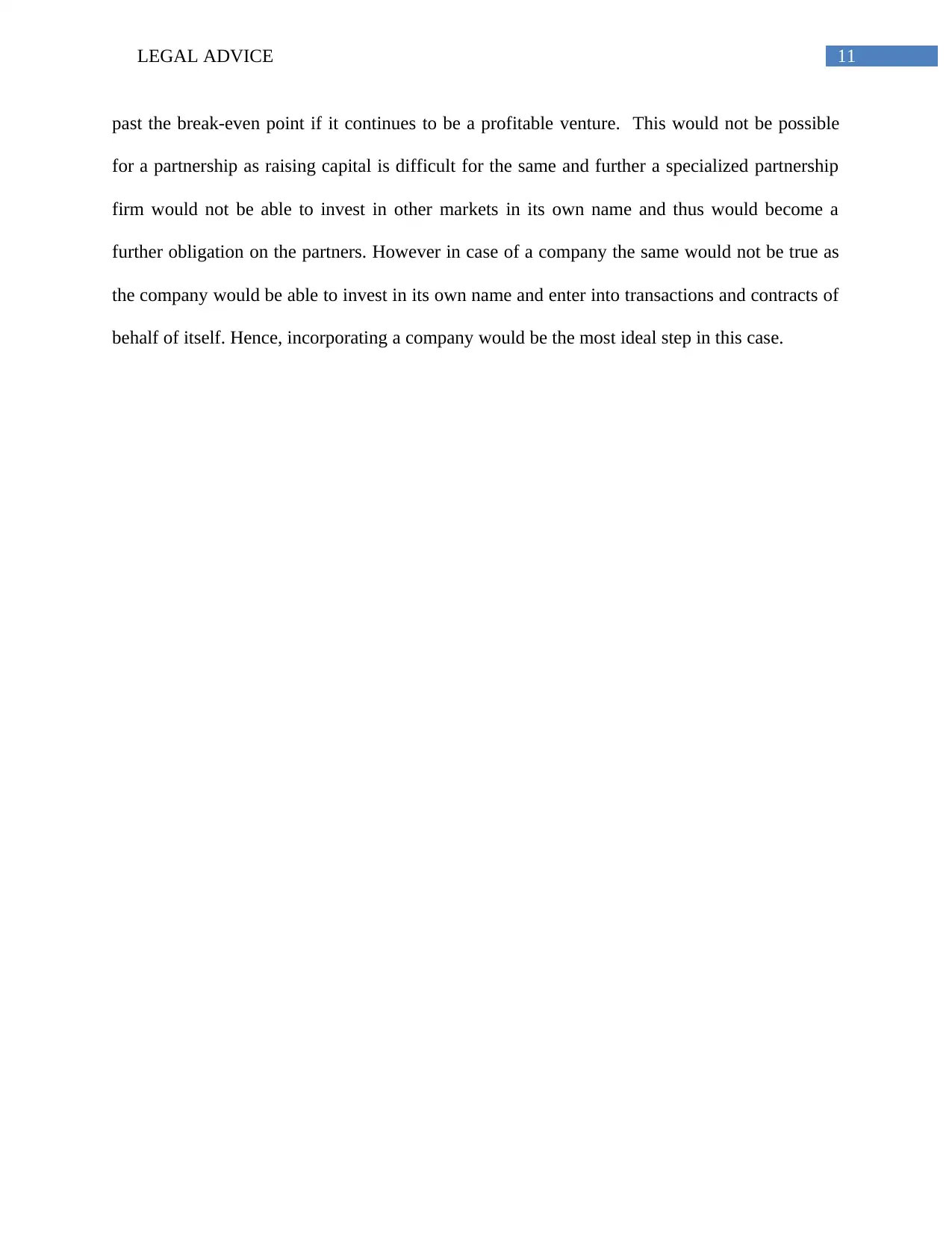
11LEGAL ADVICE
past the break-even point if it continues to be a profitable venture. This would not be possible
for a partnership as raising capital is difficult for the same and further a specialized partnership
firm would not be able to invest in other markets in its own name and thus would become a
further obligation on the partners. However in case of a company the same would not be true as
the company would be able to invest in its own name and enter into transactions and contracts of
behalf of itself. Hence, incorporating a company would be the most ideal step in this case.
past the break-even point if it continues to be a profitable venture. This would not be possible
for a partnership as raising capital is difficult for the same and further a specialized partnership
firm would not be able to invest in other markets in its own name and thus would become a
further obligation on the partners. However in case of a company the same would not be true as
the company would be able to invest in its own name and enter into transactions and contracts of
behalf of itself. Hence, incorporating a company would be the most ideal step in this case.
⊘ This is a preview!⊘
Do you want full access?
Subscribe today to unlock all pages.

Trusted by 1+ million students worldwide
1 out of 15
Related Documents
Your All-in-One AI-Powered Toolkit for Academic Success.
+13062052269
info@desklib.com
Available 24*7 on WhatsApp / Email
![[object Object]](/_next/static/media/star-bottom.7253800d.svg)
Unlock your academic potential
Copyright © 2020–2025 A2Z Services. All Rights Reserved. Developed and managed by ZUCOL.





